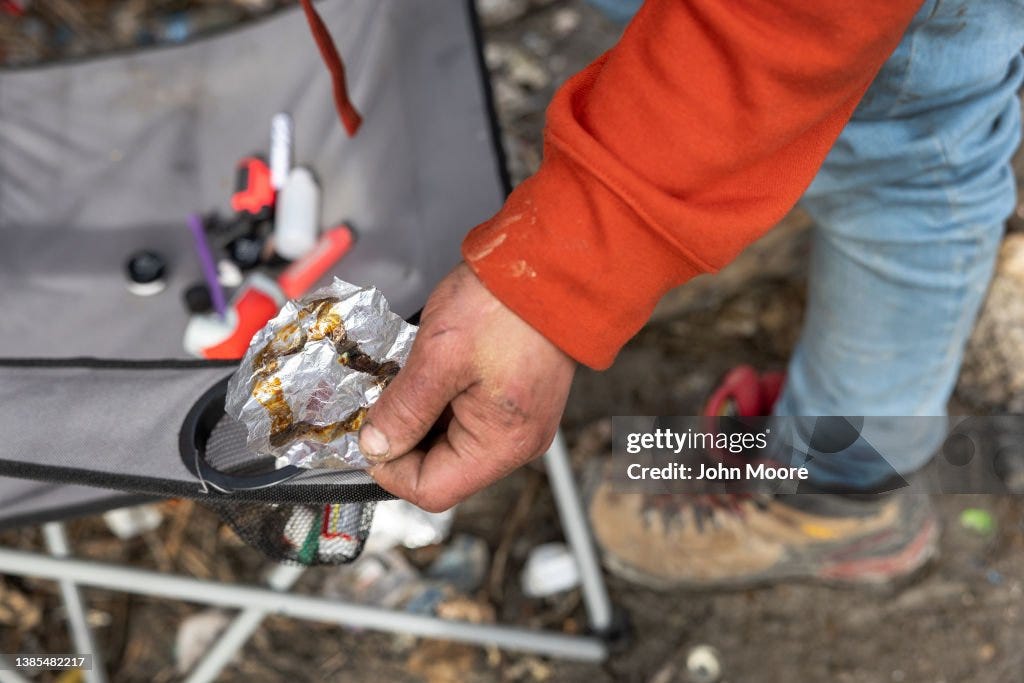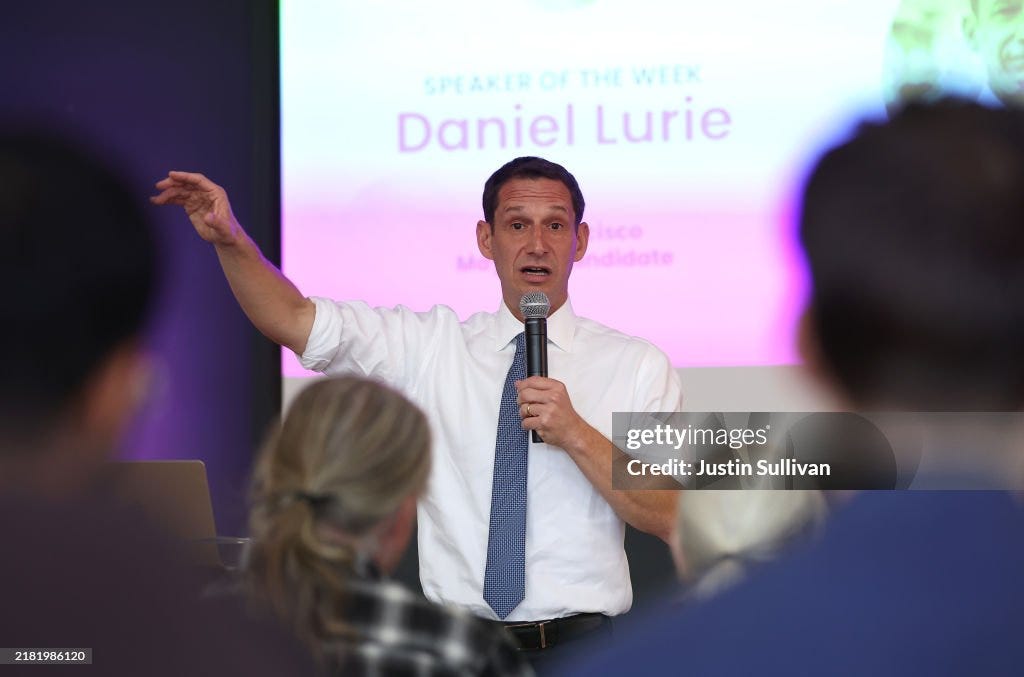Could Daniel Lurie's war on fentanyl take any casualties?
The mayor-elect wants to delcare a state of emergency on fentanyl on Day 1 of his mayorship. It could send strays at low-income residents.

SAN FRANCISCO, United States — San Francisco has rebuilt from a 7.9 earthquake, the assassination of one of its most beloved mayors, and a devastating pandemic. Yet, it’s still struggling with its most dangerous threat: fentanyl.
An opioid 100 times more lethal than morphine, fentanyl first crossed American borders over a decade ago and has become intertwined in major American cities — most notably near the border and on the West Coast. Mexican cartels, from Guadalajara to Sinaloa, have financed the black market trade for fentanyl, making it near impossible to root out of the streets of metropolises.
The problem is best illustrated in San Francisco, one of the most liberal cities in its stance toward drug policies. Drug possession in California is a misdemeanor. As a result, San Francisco officers have scaled down their approach to drug-related crimes. It's resulted in an indifferent attitude towards rooting out harmful drugs like cocaine and fentanyl and a boom in drug usage in California, creating one of the worst drug crises San Francisco has ever seen.
In a city where police and politicians are at odds on how to approach the fentanyl crisis, districts are openly decaying, and illegal drugs are being openly sold. San Francisco faces more than double the national average of fentanyl overdoses. The number could rocket as fentanyl prices sink.
Daniel Lurie has won San Francisco’s mayoral election on the idea that San Francisco has done less and less to solve the city’s fentanyl problem. Although he hasn't held public office before, Lurie spent just under $9 million on his campaign and pitched himself as the solution to the corruption that plagued San Francisco for years.
The heir to the Levi Strauss fortune has pledged to declare a city-wide state of emergency on fentanyl on Day 1 of his mayorship. He’ll find it far from simple to shut down the city’s open-air drug markets and crack down on its fentanyl epidemic without opening a Pandora’s box of social consequences for poorer San Franciscans.
Fentanyl is embedded in San Francisco neighborhoods.
Drugs are a part of California culture — as irreplaceable to the Golden State as entertainment, technology, and tourism. 10% of Californians reported using illicit drugs in the past month. Half of Californians over age 12 drank alcohol in the past year, while a fifth smoked marijuana. Nine percent fit the criteria for substance use disorder. These numbers are wildly above average compared to other states.
A big part of it is California’s proximity to Mexican cartels. The Sinaloa cartel and Jalisco cartels often go through Tijuana and into San Diego — which are only an hour apart. Per the DEA, they’ve also begun to use social media and encrypted platforms like Telegram to advertise drugs and plan transactions.
These cartels have been able to produce more fentanyl because it’s cheaper to make. It’s reported that fentanyl costs just $1 to make because fentanyl is made in laboratories. They don’t have to rely on poppy farmers to grow heroin or coca farmers for cocaine. Cartels can resell fentanyl in America for nearly ten times as much.
It’s hard to root out fentanyl because it’s so potent — two milligrams of the opioid is considered fatal. Small quantities can easily be hidden in vehicles, clothing, or inside someone. 7,200 kilograms were seized at southern border points of entry in 2022— enough to kill half of the world's population.
The sale of fentanyl in the US has exploded since 2015, creating another opioid crisis that has terrorized virtually all corners of America. It hits hardest in California, where possessing fentanyl is a misdemeanor. Police don’t stop or cite people using fentanyl, even if it’s openly in the streets, while prosecutors rarely file charges on dealers or users.
San Francisco’s unbothered attitude towards fentanyl is supported by a city-wide pro-drug culture. Activists regularly talk about the right to use fentanyl and are wary of government interference in recreational use.
The most damning piece of evidence of San Francisco’s compliance in letting fentanyl run unscathed around its streets is in its disagreement on how to tackle its growing crisis. Non-profits, hospitals, and public health agencies focus on harm reduction and social reform — offering aid to addicts. Government agencies argue for stiffer stances on drugs that include police and prison. Disagreement has bred inaction, and inaction has proven fatal for San Francisco fentanyl users.
Incoming mayor Daniel Lurie wants to get tougher on fentanyl.

Daniel Lurie will change that. At least, he says so.
The Tipping Point Community founder ran on a platform of change in one of San Francisco’s most important, contentious elections in some time. Surveys reported the lowest security rating and government confidence San Francisco had seen in over two decades. Mayor London Breed has been criticized for her response to COVID-19, her handling of fentanyl, and homelessness. Despite progress in affordable housing and clean energy, she became associated with corruption and scandals inside City Hall.
Long associated with rampant drug abuse throughout the city, Breed attempted to become harder on crime later in her term. However, she became seen as part of San Francisco’s corrupt political environment. Criticized as corrupt, it was apparent voters would shift to a new mayor.
Lurie, an outsider with no political experience, relied on his $8.9 million budget and relationship with Asian-American voters to turn the tide of the election. He criticized San Francisco's 'Machiavellian' City Hall and promised to incorporate the common man into city politics.
A huge turning point for Lurie was his stance on homelessness and substance abuse. Lurie has said that “instead of letting people live on the street and do drugs, we will give them a choice: get immediate treatment or face arrest.” Lurie also proposed harsher punishments for drug abuse and wanted to clear the open-air drug markets that plague districts like Tenderloin and Bayview-Hunters Point. His firm stance on the fentanyl crisis earned him a key nomination from the San Francisco Chronicle and a blowout victory over Breed.
“Our mandate is clear,” Lurie, a centrist Democrat, posted on X. “Deliver clean and safe streets, address our drug and behavioral health crisis, shake up a corrupt bureaucracy, build housing that our neighbors can afford, support our hardworking small businesses, and revitalize our downtown.”
Lurie has his work cut out for him. With several GOP wins across the United States, San Francisco is now a blue island resisting a red wave. He’ll have to take on a powerful City Hall bloc with the perspective of an outsider. Lurie also has to make good on his promise of change — namely dealing with rampant drug abuse, downtown tent cities, and rising levels of crime.
Lurie’s planned offensive on drugs seems naive at best.
Although November’s mayoral election was deemed a change election by City Hall insiders, Lurie and Breed’s policies are very similar. Lurie wants to build more temporary housing, get tougher on drug dealers, beef up police presence, and extend mental health programs to drug users, similar to Breed’s promises.
Lurie has said he'll declare a state of emergency on Day 1 concerning the fentanyl crisis, along with stricter punishments surrounding drug-related crimes. It could mean long-term prison sentences and heavy fines for drug dealers.
Critics liken Lurie’s stance on fentanyl to Ronald Reagan’s War on Drugs, and it’s hard to ignore the similarities. Reagan’s War on Drugs saw increased spending on law enforcement, stiffer punishments for dealing and using drugs, and decreased treatment and social reform. Lurie wants to dip into San Francisco’s rapidly decreasing budget to fund police, get harder on drug dealers, and slash social services to make up for their immense debt.
As we saw in the 1980s, a focus on incarceration over treatment led to soaring arrest rates, often disproportionately towards African Americans and Latinos, while the supply of illegal drugs like marijuana and heroin remained high.
The firm policing of those who are involved with drugs will hurt low-income citizens more than ever. Police are usually poorly equipped to handle drug abuse – whether it’s overdose or arrests. The death of Breonna Taylor in a drug raid gone wrong and Eric Garner in response to marijuana possession are prime examples.
Lurie also pledges to be firmer on the homeless. “We're going to offer people shelter beds. We're going to offer people bus tickets home. And then we're going to build those mental health and drug treatment beds,” Lurie told NPR. “We are going to give people on the streets those three options, but there will no longer be an option to stay on our streets.”
It’s a tough-love approach many San Francisco mayor candidates proposed throughout the election. As Breed's harm-reduction policies showed little sign of working, the sitting mayor turned extremely aggressive in her approach to homelessness and drug abuse by drug testing random welfare recipients, a move widely criticized by experts.
Lurie wants to establish specialized police units that would give users a choice between jail and a drop-off crisis center.
His proposed policies of forcibly taking people off the streets mirror the tent sweeps that Breed and New York City Mayor Eric Adams have been widely criticized for. Although Lurie told NPR that it wouldn’t be realistic or right to take out all tents during his mayoral tenure, his comments indicate an unforgiving approach to the homeless.
Research conducted by a group of San Francisco sociologists indicates that criminalization of homelessness — like Lurie has proposed — only increases homelessness in the long term, disqualifying them from social benefits and making it harder to get professional help.
Lurie will benefit from a nationwide decrease in fentanyl. San Franciscans have reported that the drug is getting weaker, more expensive, and harder to find. Overdose deaths around America have decreased. Yet San Francisco’s issues with rezoning and affordable housing could only worsen their issues with homelessness and thus their issue with fentanyl.
Lurie entered his mayorship promising a shift away from London Breed’s disastrous term that saw increasing usage of fentanyl on the streets. However, the culture of conformity inside City Hall, Trump’s victory, the difficulty of tracking down fentanyl, and more obstacles could get in his way of building a bigger, better San Francisco.
The outsider to politics has his work cut out for him. He says ‘Don’t count out San Francisco,’ but it will take more than deep pockets and financial backing to free San Francisco from one of the worst crises it’s ever seen.



